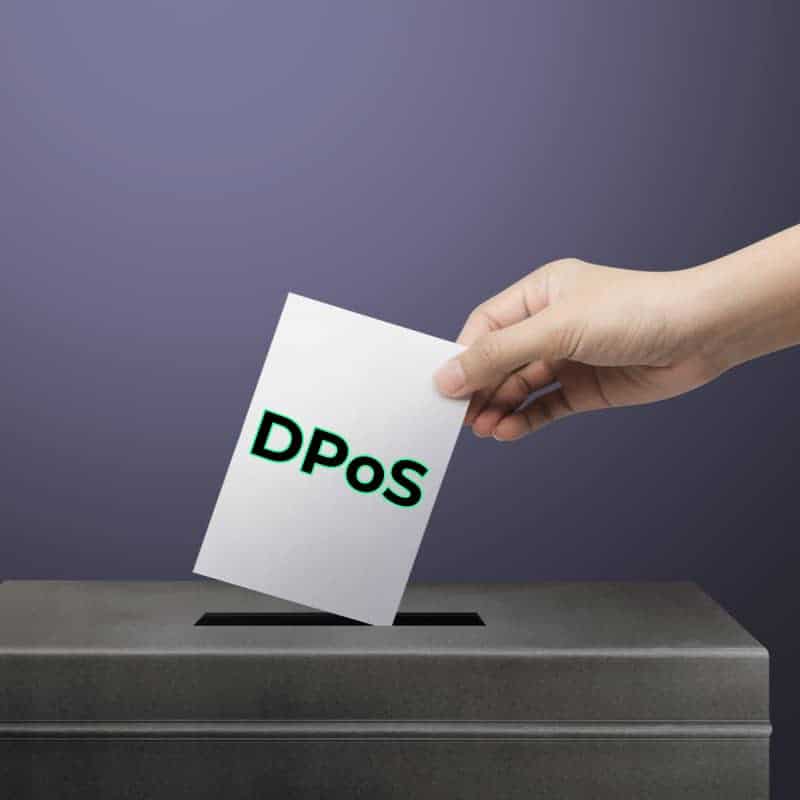Though delegated proof of stake (DPoS) is far from the original Bitcoin (BTC) protocol, some say it’s the most in line with the original concept of decentralization. Here’s everything you need to know about this new method of reaching consensus on the blockchain.
Proof of Stake (PoS) Recap
What is proof of stake (PoS)? It’s a method of reaching consensus on the blockchain and adding those transactions to the ledger.
Proof of Stake uses an algorithm for selecting delegates to perform functions equivalent to “mining” Bitcoin (BTC). The odds of becoming a delegate increase based on your “stake,” meaning how much cryptocurrency you hold.
For the work they do, PoS delegates receive rewards in the form of users’ transactions fees. But because this system very easily leads to the rich getting richer, various methods aim to introduce randomization, age-based selection and other workarounds.
What is Delegated Proof of Stake (DPoS)?
Delegated Proof of Stake (DPoS) is a method for validating transactions and adding them to the shared ledger of a blockchain network. Unlike alternative methods, DPoS networks using real-time voting in addition to algorithms to elect a pool of delegates. This is why we call it “delegated” proof of stake.
What Delegates Do

Jirsak/Shutterstock
Delegates have the power to validate transactions and create blocks—or not. And they receive transactions fees as rewards for their work. Delegates compete for votes, which are always ongoing, allowing users to quickly remove bad actors and sanction bad behavior.
Furthermore, as compared with proof of work (PoW), delegated proof of stake is much less energy consumptive. It is also capable of faster transactions speeds. But one of the defining features of DPoS is its ability to increase decentralization at a fraction of the cost of. This reduces inflation and keeps increasing value.
Who Invented It
Dan Larimer invented delegated proof of stake. The idea for this came from an essay he wrote about decentralized corporations.
Larimer also created the first Decentralized Autonomous Organization (DAO). There is a direct line from the technological leap that spawned the DAC concept to today’s DPoS systems. BitShares, one of Larimer’s first projects, implemented this new consensus mechanism in 2014.
DPos Step-by-Step
- Voting for Delegates: Using reputation algorithms and real-time voting, users create a panel of limited, trusted parties, i.e. “delegates.”
- Creating Blocks: Delegates have the power to create blocks to add to the blockchain. They can also deny un-trusted parties. Delegates validate blocks in random order. If one says no, the choice goes to the next randomly chosen delegate.
- Delegate Behavior Published on the Blockchain: This lets the community constantly review the activity of elected delegates. If the community doesn’t like what it sees, it can vote a delegate out.
DPoS vs PoS

I’m friday/Shutterstock
- It’s cheaper and faster. Delegated proof of stake (DPoS) uses more efficient algorithms than PoS. Efficient transactions are less energy-intensive and therefore cheaper and faster.
- It issues staking rewards to more people. Because the pool of delegates is constantly changing, more users on the network have a higher chance of receiving block rewards. In other words, it generally pays more to hold a stake in a DPoS coin than in a PoS coin.
- This protocol solves the “rich get richer” problem. Stake isn’t the only criteria determining who will and who won’t validate a block and receive the reward. Instead, real-time voting and reputation determine delegates based on who can best meet the needs of all users. So if someone is just hoarding fees, the community will quickly vote them out.
- DPoS incentivizes network development. Because delegates compete for their jobs, delegates that re-invest their rewards in the platform tend to keep their jobs longer.
- Users can choose the degree of decentralization. Unlike PoS, DPoS networks can vote to raise or lower the number of delegates. But in order for this platform to be successful, its users have to be able to make informed decisions.
6 DPoS Cryptocurrencies

Raevsky Lab/Shutterstock
Here are 6 examples of delegated proof of stake (DPoS) cryptocurrencies.
BitShares (BTS)
Market Cap: $164,200,000*
https://bitshares.org/
BitShares (BTS) was founded by Daniel Larimer. It’s a DEX, or decentralized exchange, allowing users to trade cryptos without leaving the blockchain. It’s also one of the most popular delegated proof of stake (DPoS) platforms.
*All market caps are rounded to the nearest hundred thousand.
EOS (EOS)
Market Cap: $3.392,900,000
https://eos.io/
EOS has the highest market cap of those on our list. This blockchain protocol is a popular DApp platform for commercial projects. Think of it as a web-based platform for developers, except unlike others, it’s decentralized.
Developers need to hold EOS coins to access services within the platform.
Steem (STEEM)
Market Cap: $142,700,000
https://steem.com/
Steem is an incentivized blockchain social media platform allowing users to create and curate content in exchange for STEEM, the platform’s native currency. Steem’s blockchain uses DPoS consensus.
Lisk (LSK)
Market Cap: $239,900,000
https://lisk.io/
Lisk is a blockchain technology platform utilizing smart contracts on a decentralized network. LSK, what is an ERC20 token is governed with DPoS consensus. Users vote for all 101 total delegates.
Oxycoin (OXY)
Market Cap: $2,500,000
https://oxycoin.io/
OXY has a lower market cap, but compard to other delegated proof of stake (DPoS) platforms, it has a very high number of delegates. Stakeholders vote for 51 of the 201 total delegates in the pool.
Ark (ARK)
Market Cap: $54,700,000
https://ark.io/
Ark aims to provide all-in-one blockchain solutions for businesses. The network boasts 8 second block times, making it one of the fastest networks in the industry. ARK, the native coin, uses a Delegated Proof-of-Stake to issue block rewards.
A New Take on Consensus
There are more and more ways to reach consensus on a blockchain, and delegated proof of stake is one of the newer ones. How does it differ from other protocols?
For starters, delegated proof of stake (DP0S) can be faster, cheaper and more energy efficient. More broadly, it’s considered to be more democratic.

